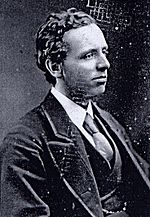Henry Edward Armstrong facts for kids
Quick facts for kids
Henry Edward Armstrong
|
|
|---|---|

Henry Edward Armstrong as a young man
|
|
| Born | 6 May 1848 |
| Died | 13 July 1937 (aged 89) Lewisham, London, England
|
| Nationality | British |
| Awards | Davy Medal (1911) Fellow of the Royal Society |
| Scientific career | |
| Fields | Chemistry |
| Doctoral advisor | Hermann Kolbe |
| Doctoral students | Martin Lowry |
Henry Edward Armstrong (born May 6, 1848 – died July 13, 1937) was an important British chemist. He did a lot of scientific research. But he is best known for his ideas about teaching science. A chemical called Armstrong's acid is even named after him!
Contents
Life of a Chemist
Early Life and Education
Henry Edward Armstrong was born in Lewisham, a part of London, England. His father was Richard Armstrong. Henry lived in Lewisham for most of his life.
After school, when he was 16, Henry spent a winter in Gibraltar. He went there for his health. In 1865, he came back to England. He started studying at the Royal College of Chemistry in London. This college is now part of Imperial College. At just 18, he helped a scientist named Edward Frankland. They worked on finding harmful things in dirty water.
Armstrong continued his studies in Germany. He worked with Hermann Kolbe in Leipzig. In 1869, he earned his PhD. His research was about "acids of sulfur." He then returned to London. He taught chemistry classes at St Bartholomew's Hospital.
Becoming a Professor
In 1879, Armstrong got a permanent job. He worked at the City and Guilds of London Institute. This is also now part of Imperial College. In 1884, at age 36, he became a Professor of Chemistry. This was at the Central Institution. There, he created a three-year course. It was for students wanting to study chemical engineering. He saw that British industries needed more scientific thinking.
Important Discoveries
Armstrong began studying naphthalene in 1881. He looked at how to create and break down its structures. He built on earlier work about benzene. His main helper was W. P. Wynne. They collected 263 naphthalene samples. These are still kept at Imperial College today. This research helped the synthetic dye industry a lot.
Later, Armstrong studied terpenes, like camphor. He also worked on water purification. His work helped stop typhoid fever. He also studied crystallography. This is the science of crystals.
In 1887, Armstrong became interested in how atoms attach to benzene. In 1890, his own idea for benzene's structure appeared. He thought that six "forces" acted within a cycle. This idea came before the discovery of the electron. It also came before modern ideas about aromaticity. Armstrong understood that these forces had direction. He might have predicted parts of later theories.
He died at his home in Granville Park, Lewisham.
Family Life
Henry Armstrong married Frances Louisa Lavers. They got married on August 30, 1877. They had seven children together. They had four boys and three girls. All of his children lived longer than him. His wife passed away just before him. She was 93 years old.
Awards and Groups
- Fellow of the Royal Society (1876)
- President of the Chemical Society of London (1893–1895)
- Davy Medal (1911)
- Messel medal from the Society of Chemical Industry (1922)
- Horace Brown Medal (1926)
- Albert Medal (1930)
Images for kids


